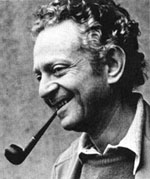Spokesman Leon Lederman (An Unauthorized Autobiography)

Leon M. Lederman.
Leon Lederman is one of the oldest, barely active particle physicists seen at Fermilab. He began his career back in 1946 when delivering a telegram to someone in the Pupin Physics building of Columbia University; he got lost in the labyrinth of tunnels and emerged four years later with a Ph.D. He began his research at the Nevis cyclotron and helped invent the first pion beam. He started counting pions in 1951 and when he reached 4,722,938, two of his graduate students hung themselves, and one was committed.
In 1953 he carried out a brilliantly-conceived pion scattering experiment that missed the N* resonance. His period of greatest creativity came in 1956 when he heard a lecture by Gell-Mann on the possible existence of neutral K mesons. He made two decisions: First, he hyphenated his name. Then he determined to find the neutral K meson. Working at top speed Lede-rman and his group constructed an accelerator at Brookhaven and put the cloud chamber in the beam. In 1956 they found the neutral K meson and proved that charge conjugation is conserved in weak decays. Flushed with success Lede-rman decided to have an END OF RUN PARTY. Unfortunately, due to a typist's confusion, it came out END OF PARITY RUN and led to the widespread, but mistaken, notion that parity had been violated. This also proved that charge conjugation was not conserved in weak decays. Oh well. Lede-rman was promoted and sent to CERN. There he started the famous g-2 experiment and managed to confuse it so badly that it took 26 physicists nineteen years to finish.
In 1961 he worked under M. Schwartz and J. Steinberger on Neutrinos. He was in charge of finding neutral currents. Schwartz was in charge of finding Lede-rman. In 1968 he invented the di-muon experiment and missed the J/Psi particle. In 1969 Lede-rman invented the high speed digital computer but his ideas were stolen by IBM. Since that time he has resolutely refused to use computers. In 1972 while at CERN to see what was delaying the g-2 experiment, he stumbled on high transverse momentum pions, but missed the J/Psi. In 1974 he gave the main Fermilab dedication address. Fortunately, his words were obscured by an unusual wind. His group then looked for direct leptons and missed the J/Psi. The great success of E-288 owes much to the fact that Lede-rman was very busy on his memoirs during most of the crucial phases of the Upsilon experiment.
[Click here to see Leon M. Lederman's edited autobiography, published at www.nobelprize.org]


